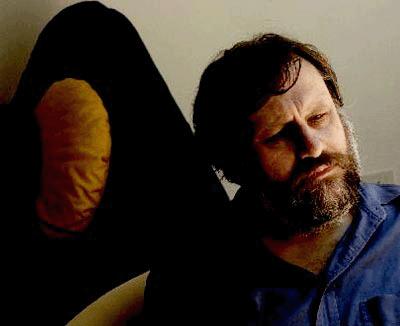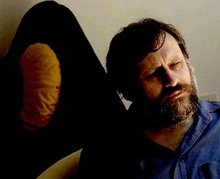[3]
Take a strip of paper
Make sure that it has two sides
Take one end of the strip, make a 180 degree twist, and put it to the other end.
Tape - or, better, with respect to suture, which is important, as we will see - stitch the two ends together.
As a result, you now have a one-sided figure instead of a two- sided figure.
Ill 1: The Moebius Strip
The Moebius Strip subverts the normal, i.e. Euclidean way of spatial (and, ultimately: temporal) representation, seemingly having two sides, but in fact having only one. At one point the two sides can be clearly distinguished, but when you traverse the strip as a whole, the two sides are experienced as being continuous. This figure is one of the topological figures studied and put to use by Lacan. (19) On the one hand, Lacan employs the Moebius Strip as a model to conceptualize the "return of the repressed," an issue important in Lost Highway as well. On the other hand, it can illustrate the way psychoanalysis conceptualizes certain binary oppositions, such as inside/outside, before/after, signifier/signified etc. - and can, with respect to Lost Highway, characterize Fred/Pete. These oppositions are normally seen as completely distinct; the Moebius Strip, however, enables us to see them as continuous with each other: the one, as it is, is the "truth" of the other, and vice versa. Reni Celeste invokes a similar topology, when she comments on Lynch's rewriting of American metaphysics, a rewriting that emphasizes the position where "violence meets tenderness, waking meets dream, blond meets brunette, lipstick meets blood, where something very sweet and innocuous becomes something very sick and degrading, at the very border where opposites becomes both discrete and indistinguishable" (Celeste).
Escher's Moebius Ring - Ants: 
In Lost Highway, the merging of opposites is crucial, and the problematization of the inside/outside opposition is a most important issue. In fact, it is an important issue in Lynch's oeuvre as such - it suffices to refer to the scene in Blue Velvet, when the camera intrudes the severed ear that Jeffrey finds, and at the end of the movie, the camera virtually seems to come out of Jeffrey's ear again. In Lost Highway, the question of inside and outside and their conflation is repeatedly posed. On a general level, the diegetic reality of the movie - that what we actually see on the screen, as it were, INSIDE the movie - is composed out of bits and pieces from other movies: Lynch uses the different genres of Hollywood as a kind of quarry. And not only the Hollywood genres: he almost violently exploits his own wealth of images, almost every shot initiates the shock of recognition. One might call this repetitiveness, but, after all, language in general - and especially a distinct film-language such as Lynch's - relies on repetition in order to function.

Another specific example of the merging of inside and outside apart from the frame-tale (Dick Laurent is dead) already mentioned, is, most important, the scene in which Fred meets the Mystery Man for the first time. In fact, the Mystery Man - simultaneously being inside and outside - can be read at the place where these (and in fact: all) opposites meet, he is - so to speak - the twist in the Moebius strip. In Lacan's use of the Moebius Strip, the place denoting the suture of the imaginary and symbolic in a way "hides" the primordial cut that instigated this topological figure in the first place, the cut that is the unconscious (or, in Lacanian terminology: the real). It is by suturing off the real that reality for the subject remains a coherent illusion, that prevents the subject from falling prey to the real, that is, falling into psychosis. It is no wonder, then, that the Mystery Man always appears when a change in personality is close.
Reni Celeste is correct when she observes that in Lost Highway, there are three important fissures: "that which exists between one discrete individual and another, that which exists between the individual and itself, and that which exists between the thing and its representation ... Th[e] Nameless Man [Celeste's name for the Mystery Man] ... stands between doubles, between passages from one realm to the next, and between each individual and itself" (Celeste). However, it is important to note that the structure of the Moebius Strip re-conceptualizes these fissures, allowing them to be seen not so much as fissures, or ruptures, but as places of transition. Lost Highway's moebial structure disallows the suture of the subject into the narrative. In contrast to the traditional Hollywood diegesis, in which the narrative unfolds in a straightforwardly telelogical manner - even in spite of displacing strategies such as flashbacks, or the "film within the film"-motif - Lost Highway in fact presents a multiple diegesis. The more so, since both stories - the story of Fred and the story of Pete - are not simply related to each other as prequel, and/or the solution of the other. Although there are definite anchoring points that clearly connect the two stories: the one does not subsume the other without remainder. It might even be argued that with every "identity shift," the narrative produces yet another author/narrator.
______________________________________________________________________________









No comments:
Post a Comment